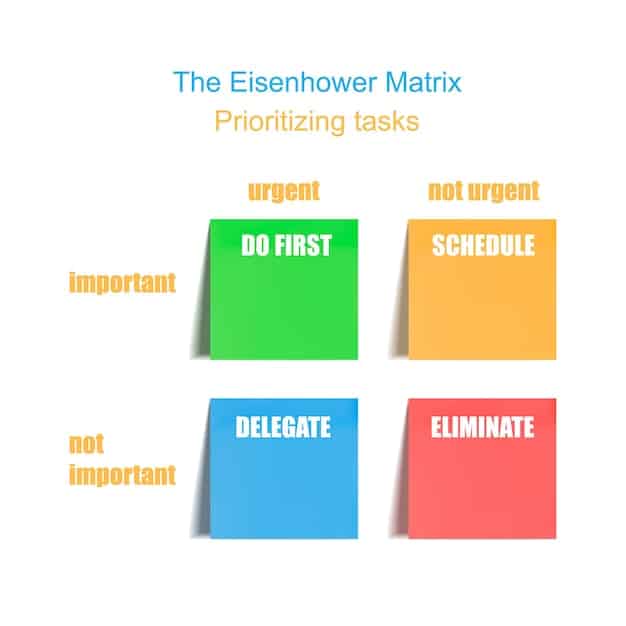Eisenhower Matrix: Your Guide to Prioritization & Productivity

The Eisenhower Matrix, also known as the Urgent-Important Matrix, is a powerful time management tool that helps you prioritize tasks by categorizing them based on their urgency and importance, allowing you to focus on what truly matters and eliminate distractions.
Feeling overwhelmed by your to-do list? Discover how the Eisenhower Matrix: Prioritize Tasks and Eliminate Distractions for Peak Productivity can revolutionize your time management and boost your focus.
Understanding the Eisenhower Matrix
The Eisenhower Matrix, a simple yet effective tool, has been used for decades by leaders in various fields to enhance productivity. Let’s delve into what makes this matrix so helpful.
At its core, the Eisenhower Matrix is a decision-making framework that helps you sort tasks based on their urgency and importance. This clear categorization enables you to decide what you should focus on, delegate, postpone, or eliminate. But how exactly does it work?
The Four Quadrants Explained
The matrix is divided into four quadrants, each with a specific action associated with the tasks that fall into it.
- Urgent and Important: These are tasks that demand immediate attention and have significant consequences.
- Important but Not Urgent: These are activities that contribute to long-term goals and success.
- Urgent but Not Important: These tasks often involve interruptions and can be delegated.
- Not Urgent and Not Important: These are time-wasting activities that should be eliminated.
This structure helps to provide a structured way to allocate your time and energy to different tasks, making sure that you address all areas.
By learning to identify and categorize tasks correctly, you can effectively manage your workload, reduce stress, and achieve your goals with greater precision. The ability to distinguish between what truly matters and what merely seems pressing is a game-changer for anyone looking to boost their productivity.

How to Implement the Eisenhower Matrix
Now that we understand the underlying principles of the Eisenhower Matrix, it’s time to explore how to put it into practice. This involves several key steps and consistent application.
First and foremost, you need to clearly define your tasks. This might seem obvious, but a poorly defined task can skew your assessment of its urgency and importance. So, begin by itemizing everything on your to-do list.
Step-by-Step Guide to Implementation
Here’s a detailed process to effectively implement the Eisenhower Matrix:
- List All Your Tasks: Start by creating a comprehensive list of all tasks, both big and small, that demand your attention.
- Assess Urgency: Determine which tasks require immediate action. These are often time-sensitive or have pressing deadlines.
- Determine Importance: Evaluate which tasks contribute most to your long-term goals and overall objectives.
- Categorize into Quadrants: Place each task into one of the four quadrants based on your assessment of urgency and importance.
Regularly review and update your matrix. Things change, and keeping your matrix up-to-date is essential for it to be effective.
Implementing the Eisenhower Matrix isn’t a one-time activity; it’s an ongoing process. Make it a part of your daily or weekly routine to continuously refine your priorities and enhance your productivity.
Benefits of Prioritizing with the Matrix
Using the Eisenhower Matrix offers a range of benefits that go beyond mere task management. Let’s explore some of the advantages it brings.
The most obvious benefit is enhanced productivity. By focusing on what truly matters, you avoid wasting time on less important tasks, thus accomplishing more in less time. But the benefits don’t stop there.
Key Advantages of Using the Eisenhower Matrix
The benefits cover various aspects of productivity and personal well-being:
- Increased Efficiency: Prioritizing tasks allows you to allocate your time and energy more effectively.
- Stress Reduction: Having a clear overview of your priorities reduces feelings of overwhelm and anxiety.
- Better Decision-Making: The matrix helps you make informed decisions about what to tackle, delegate, or ignore.
- Improved Focus: Eliminating non-essential tasks helps you concentrate on what’s important.
Ultimately, implementing the Eisenhower Matrix is about taking control of your time and energy. It empowers you to make more informed choices, reduce stress, and achieve your goals with greater efficiency.
With consistent application and a clear understanding of your priorities, it can transform the way you approach your daily tasks and responsibilities.

Common Mistakes to Avoid
While the Eisenhower Matrix is a great tool, it’s easy to make mistakes during implementation that can reduce its effectiveness. Recognizing and avoiding these pitfalls is a key part of leveraging the matrix.
One of the most common mistakes is incorrectly assessing a task’s urgency and importance. This can lead to misallocation of time, focusing on less important things, or missing tasks that are genuinely important.
Pitfalls and How to Dodge Them
Here are some common mistakes and how to address them:
- Misjudging Urgency and Importance: Take the time to thoroughly evaluate your tasks.
- Failing to Delegate: Overcome the urge to control everything and trust others with tasks that can be delegated.
- Neglecting Important but Not Urgent Tasks: Make time for these tasks consistently to avoid crises.
- Inconsistent Use: Use the Eisenhower Matrix regularly to continually refine your priorities.
By being proactive and avoiding these common pitfalls, you can ensure that the Eisenhower Matrix remains an effective tool for time management and productivity.
Recognizing these potential errors can allow you to refine your method and get the most benefit possible.
Adapting the Matrix to Different Contexts
The Eisenhower Matrix is versatile and can be adapted to various contexts, from personal planning to professional project management. Understanding how to tailor the matrix to suit different needs is crucial for maximizing its utility.
For instance, in a professional setting, the matrix can be applied to team projects, helping team members prioritize tasks and allocate resources effectively. In contrast, for personal use, the matrix can assist in managing daily routines and long-term goals.
Tailoring the Eisenhower Matrix
The matrix’s adaptability makes it valuable in numerous contexts:
- Personal Productivity: Use it to manage daily tasks, hobbies, and personal goals.
- Project Management: Apply it to allocate resources and prioritize tasks within a team.
- Strategic Planning: Use it to align actions with long-term organizational objectives.
The key to successful adaptation is to remain flexible and adjust the way you use the matrix to meet specific needs. It’s a adaptable tool that can be customized to different situations.
By tailoring the Eisenhower Matrix to suit different environments, it may become a more powerful method for accomplishing goals and boosting productivity.
Real-Life Examples of the Eisenhower Matrix in Action
Let’s examine some real-life scenarios where the Eisenhower Matrix can make a significant difference, providing a clear understanding of its practicality.
Imagine a project manager overwhelmed with numerous tasks. By using the matrix, they can identify which tasks demand immediate attention (urgent and important), which can be scheduled for later (important but not urgent), which can be delegated (urgent but not important), and which are simply time-wasters (not urgent and not important).
Practical Applications
The matrix can be great for organizing workloads and schedules:
A marketing team can use the Eisenhower Matrix to prioritize tasks such as immediate campaign launches, long-term brand-building activities, delegating administrative duties, and eliminating unproductive meetings. A student can use the matrix to organize study schedules, prioritizing urgent assignments, planning long-term exam preparations, delegating group project tasks, and avoiding distracting social media.
These examples show that the Eisenhower Matrix is practical for various scenarios, both professional and personal. It provides a structured approach to prioritize tasks, allocate resources effectively, and achieve goals.
By using the Eisenhower Matrix, you can translate the theory into real-world success, becoming more efficient, less stressed, and more productive.
| Key Point | Brief Description |
|---|---|
| ⏰ Quadrants | Categorizes tasks by urgency and importance for prioritization. |
| ✅ Implementation | List tasks, assess urgency/importance, and assign to quadrants. |
| 👍 Benefits | Boosts efficiency, reduces stress, and improves decision-making. |
| 🚫 Mistakes | Avoid misjudging tasks, failing to delegate, and inconsistent use. |
Frequently Asked Questions (FAQ)
▼
The Eisenhower Matrix is a prioritization tool that categorizes tasks based on their urgency and importance, enabling you to focus on tasks that truly matter, delegate or schedule other tasks, and eliminate time-wasting activities.
▼
It’s best to review and update your Eisenhower Matrix regularly, ideally daily or weekly, to ensure it reflects your most current priorities and doesn’t become outdated.
▼
Common mistakes include misjudging the urgency or importance of tasks, failing to delegate when appropriate, neglecting important but not urgent tasks, and not being consistent in using the matrix.
▼
Yes, the Eisenhower Matrix can be adapted for team or group projects to help prioritize tasks, allocate resources, and ensure all members are aligned on what needs to be done, when, and by whom.
▼
By providing a clear view of priorities, eliminating non-essential tasks, and focusing on what truly matters, the Eisenhower Matrix reduces stress and promotes better focus, enhancing overall productivity and well-being.
Conclusion
In conclusion, the Eisenhower Matrix is an invaluable tool for anyone seeking to enhance their productivity, reduce stress, and achieve their goals more efficiently. By understanding its principles, implementing it effectively, and avoiding common mistakes, you can revolutionize the way you manage your time and tasks.





